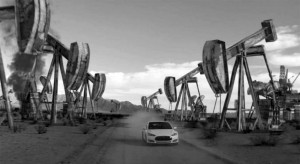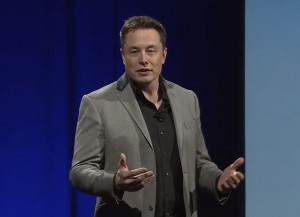Tesla got a much-needed, albeit small bump on Wall Street Tuesday, but shares of the maverick battery-carmaker have been trading near a two-year low ahead of the company’s fourth-quarter earnings announcement.
The stock is down by more than a third since the beginning of the year, a downturn significantly more severe than the bearish turn the overall stock market has been experiencing, and a sign of increased concern by key analysts like Barclay’s Brian Johnson. On Tuesday, he cut his forecast from $180 to just $160 a share.
There are still a handful of analysts who rate Tesla a “Buy,” and even a “Strong Buy,” but the mood has turned sharply in recent months, Stifel’s James Albertine summing up by cautioning, “We see few catalysts to turn short-term bears bullish.”
(Tesla beams autonomous vehicle updates to Model S owners. Click Here for more.)
Tesla will report earnings after the market closes on Wednesday. Consensus estimates predict it will deliver a profit of eight cents a share on revenues of $1.79 billion.
At a Tuesday close of $148.25, Tesla shares are trading at barely half their 52-week high of $286.65. And the recent purchase of $100 million in stock by CEO Elon Musk – which gives him a 22% stake in the company he founded – didn’t offer the typical luster that normally surrounds almost everything the South African-born entrepreneur does.
While Musk still has an expansive network of fanboys following every tweet and blog post, investors are becoming ever more focused on the fundamentals of a company that has struggled to turn a profit using even its own accounting procedures.
Things have taken a sharp turn since Tesla completed a new, $642 million stock offering last August designed to replenish its coffers drained by the cost of developing new products and start up the new Megafactory battery plant in Reno, Nevada.
Tesla has several new models coming, including a high-performance, low-volume replacement for its original Roadster, as well as its first mainstream offering, the Model 3. The latter won’t hit showrooms for well over a year, though Tesla plans to begin taken orders early this year.
The more immediate concern is what is happening with the launch of the Model X, the sport-utility vehicle complement to the Tesla Model S sedan. The rollout has been slower than expected, according to observers, a Barclays report estimating first-quarter production at Tesla’s Fremont, California assembly plant will dip to 14,200 vehicles, down from 17,400 during the final three months of 2015.
“We think the slow ramp may challenge deliveries, cash burn, and margins, while also reminding of us risks in the years ahead to Tesla’s aggressive growth ambitions,” Johnson advised investors this week.
The slowdown appears largely the result of a cautious ramp-up of Model X production, though Tesla may be working to deal with ongoing issues with the earlier Model S. The sedan has experienced a number of quality problems and endemic reliability issues cost Tesla the much-coveted “Recommended Buy” endorsement from Consumer Reports magazine last October.
“Reliability has moved from ‘Average’ to ‘Below Average,’” Jake Fisher, CR’s director of automotive testing said during a widely reported news conference. As a result, he added, “We’re no longer recommending the Model S.”
The positive side would be for owners and reviewers to report back on quality improvements, especially with the Model X. The battery-ute’s distinctive, if complicated “falcon doors” could be particularly prone to problems if Tesla doesn’t have its production process down pat, manufacturing experts caution.
(Still secret Apple car program suffers series of setbacks. Click Here for the story.)
This isn’t the first time Tesla stock has come unplugged, nor would it be the first time the battery-carmaker was able to charge investors back up.
Musk is doing his best by focusing on some of the company’s high-tech developments, such as its PowerWall battery backup system, the new AutoPilot semi-autonomous drive system and another futuristic system called Summon, which will allow a Tesla vehicle to park itself in an owner’s garage and then pull up to the front door when summoned.
“In the morning, you wake up, walk out the front door, and summon your car. It will open the garage door and come to greet you,” Musk said in a blog post.
The bigger bump could come in March, when the CEO plans to announce more details about the planned Model 3.
“We expect interest in Tesla to be reinvigorated amidst a wave of social-media attention,” said Barclay’s Johnson.
But Tesla took an unusual backhand from a traditional supporter when influential tech publication Wired issued its newest issue. It features General Motors CEO Mary Barra on its cover, standing next to a new Chevrolet Bolt. At $30,000 – after federal tax credits – and with an estimated range of 200 miles per charge, the magazine noted GM is doing what Tesla promises will come with the Model 3, but at least a year early.
(Driving the – almost production-ready – Chevy Bolt. Click Here for the story.)
Tesla still has a high-tech luster that eludes traditional makers like GM, something it is attempting to burnish with a new commercial that features a narrative voiced by the company’s namesake, electric pioneer Nikola Tesla. Visually, the spot shows a world of gritty oil wells transforming into a multi-colored environment where a Tesla Model S is charged up by clean energy from wind turbines.
It’s likely to take more than that to charge up investors in the current environment, however.
(To view the new Tesla spot, Click Here.)




Tesla can still fool some of the people, some of the time.